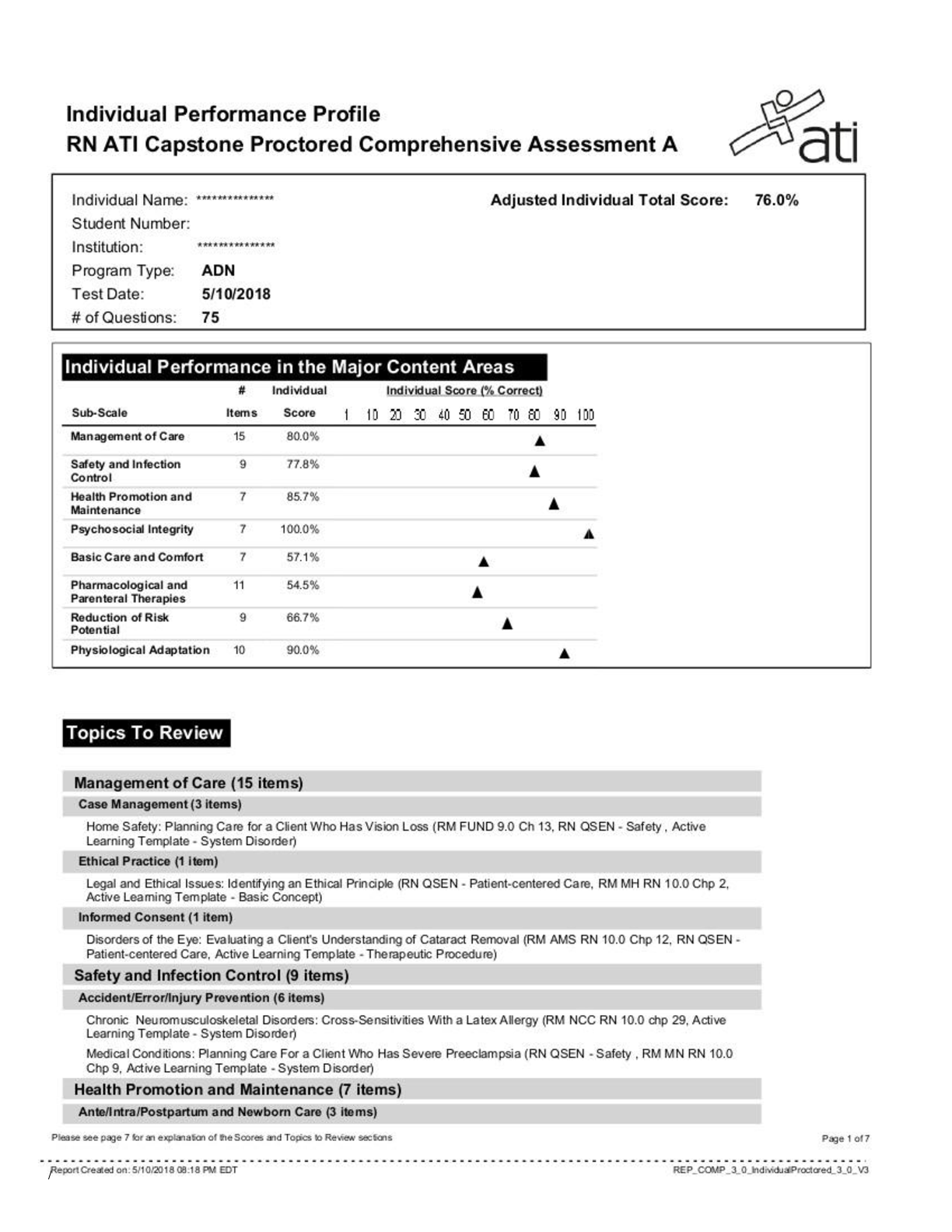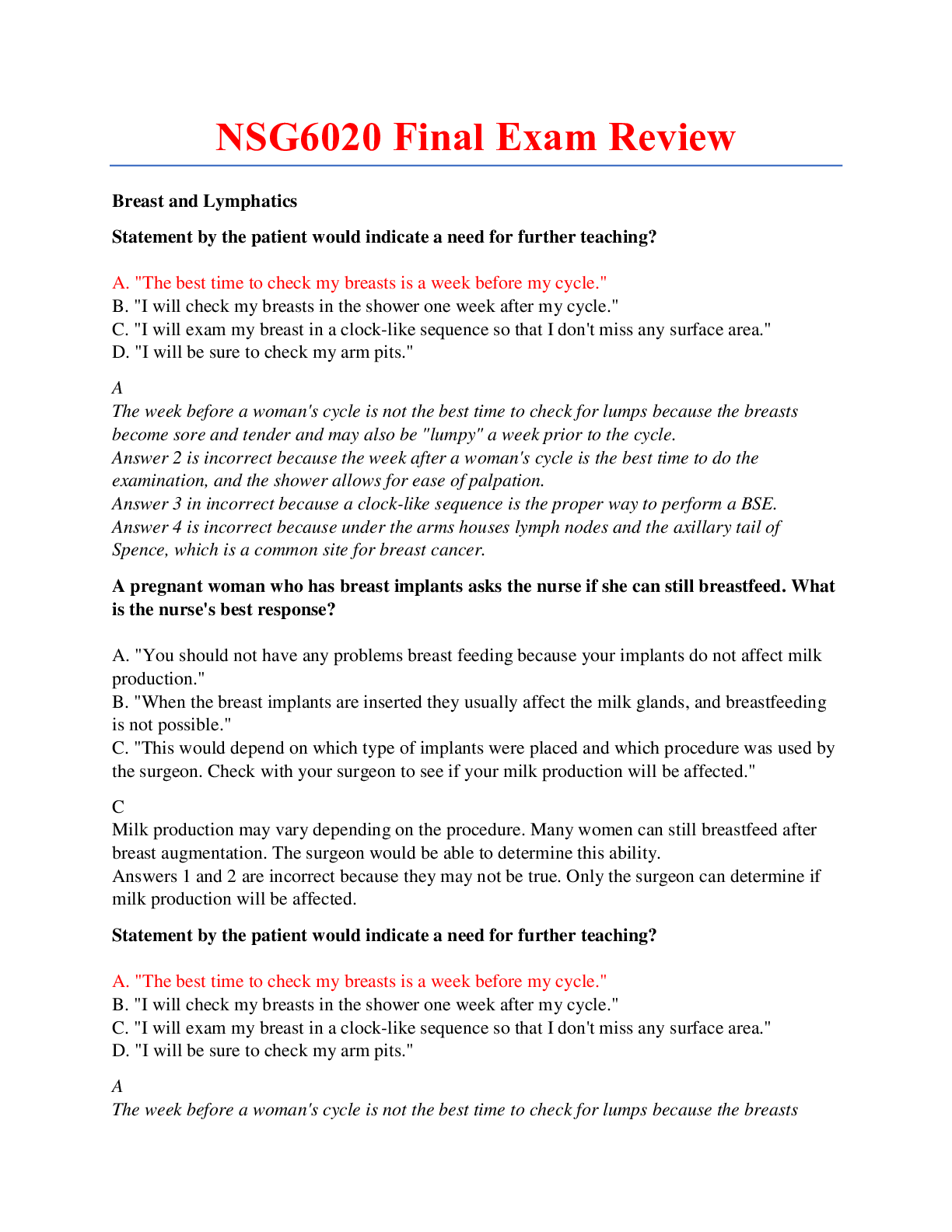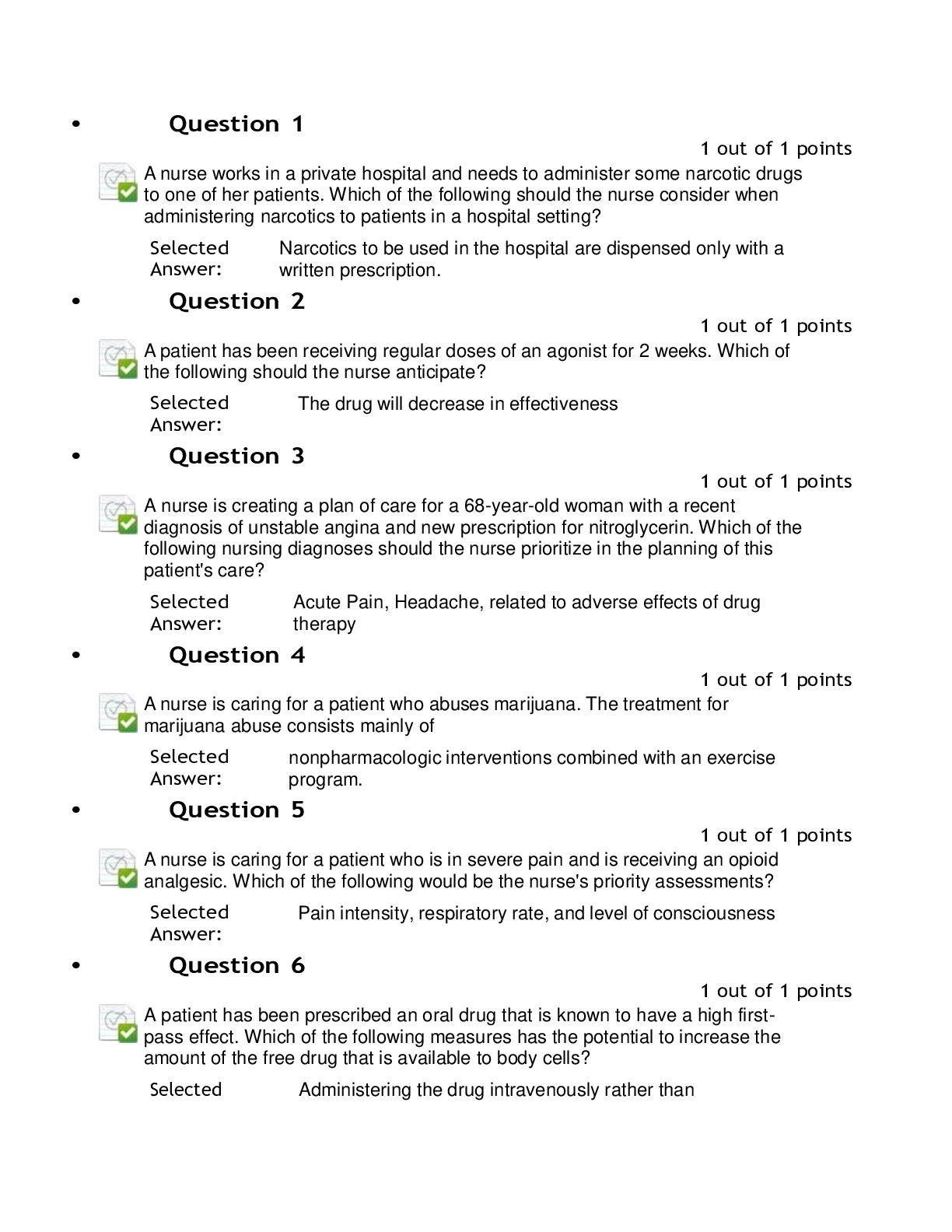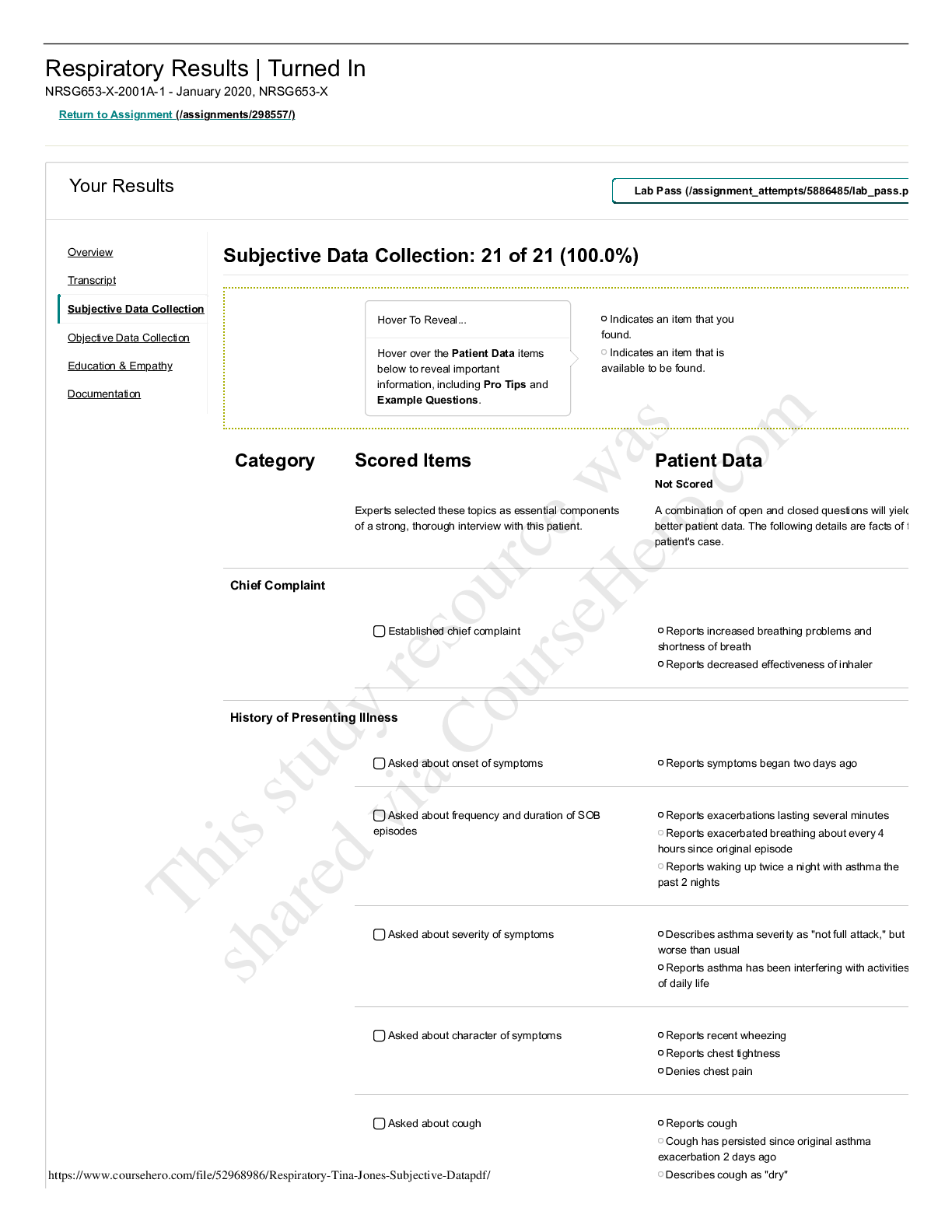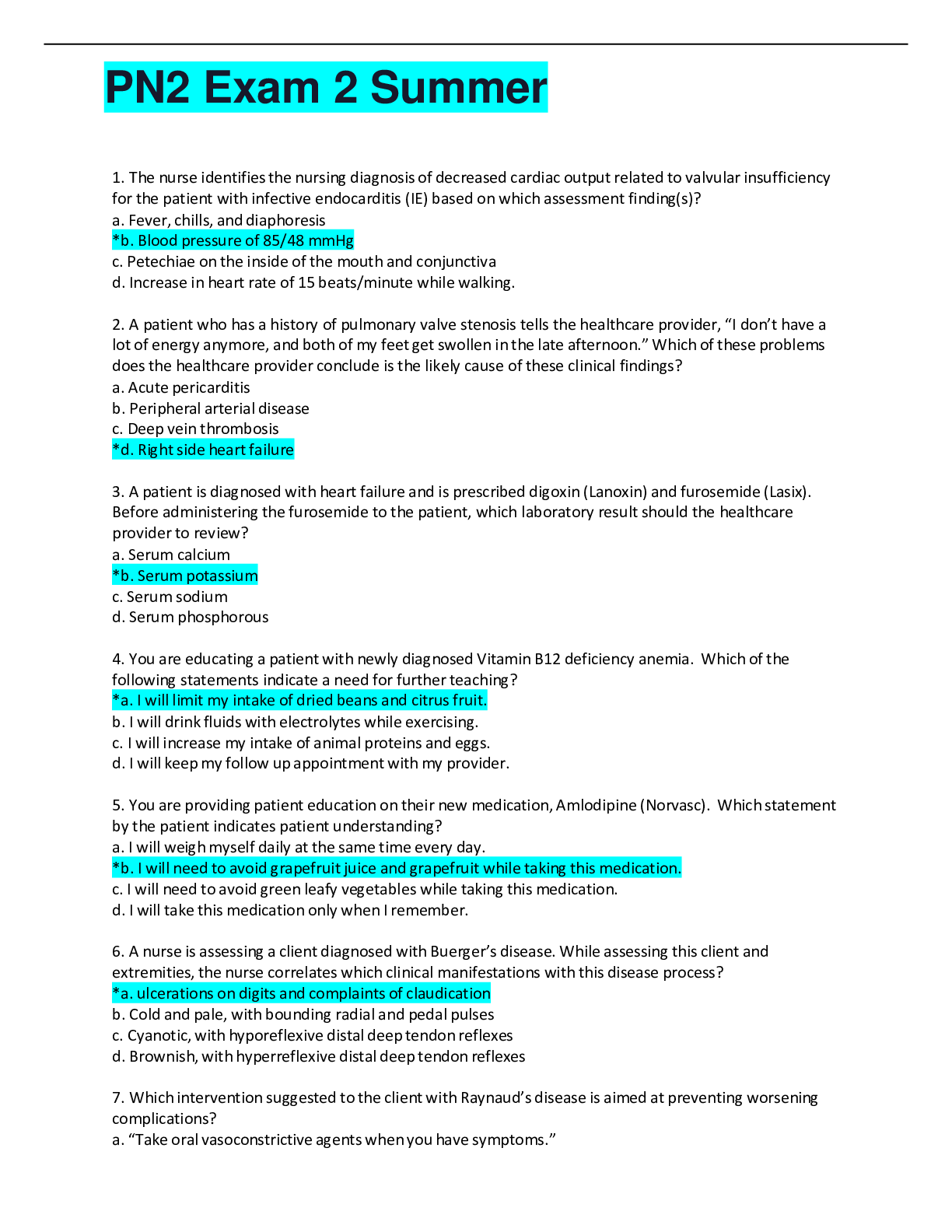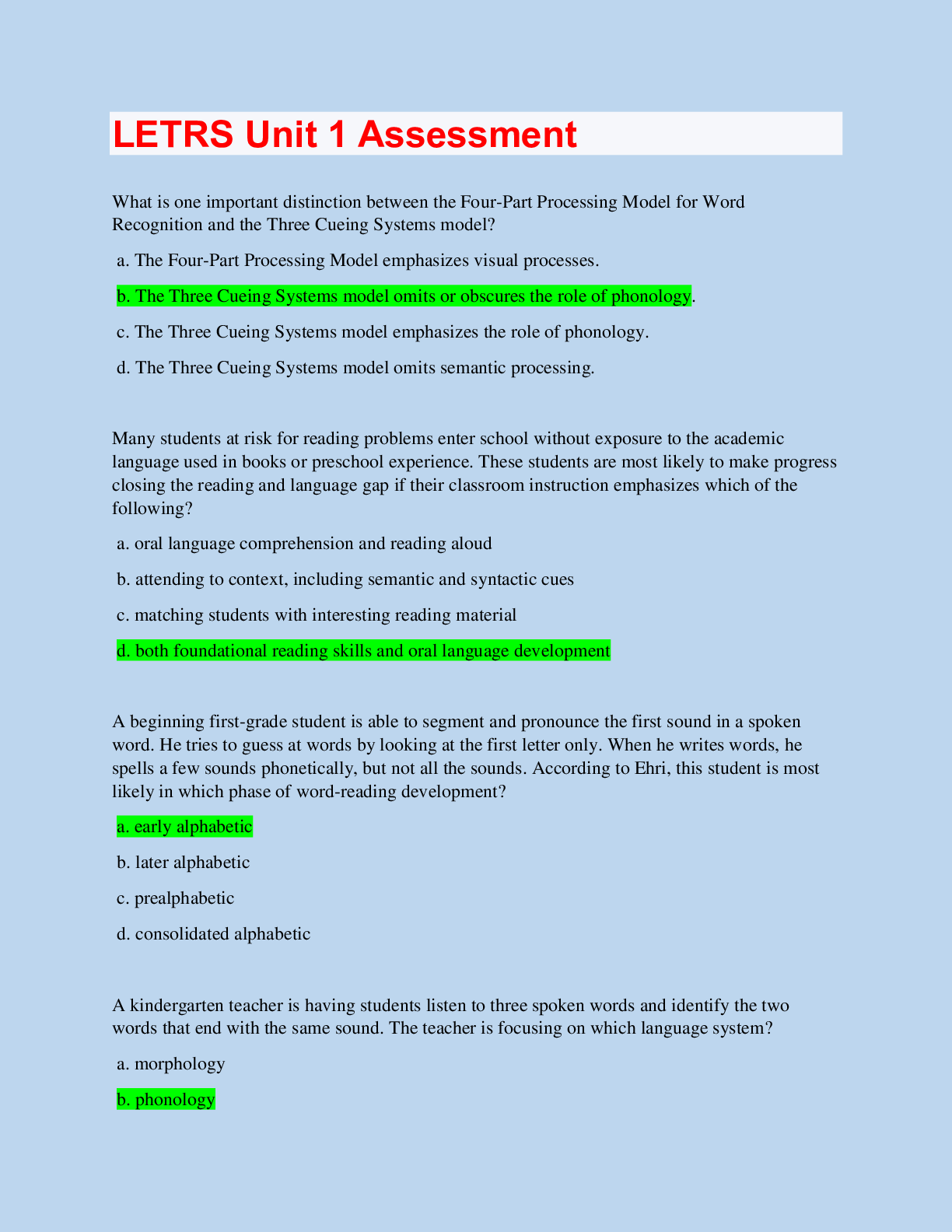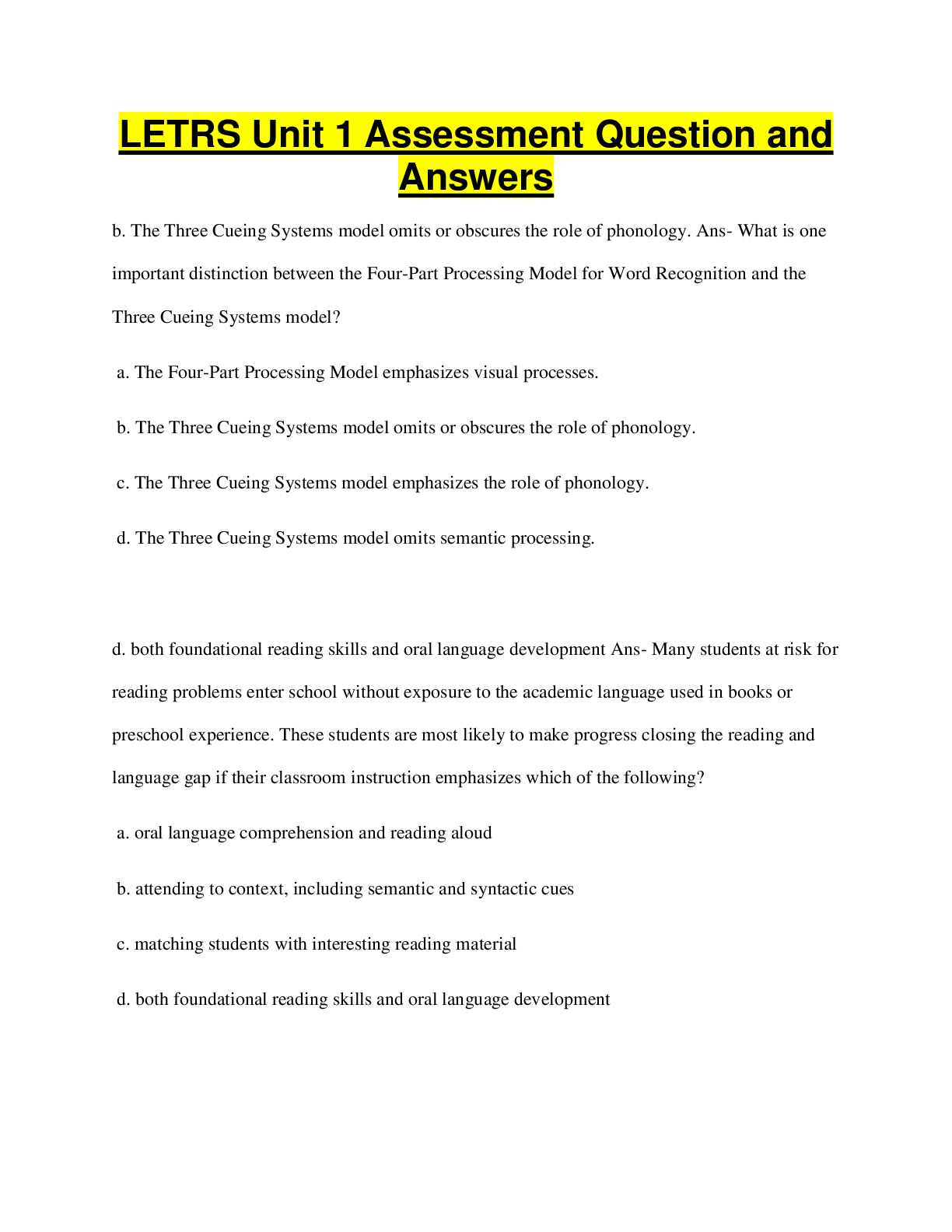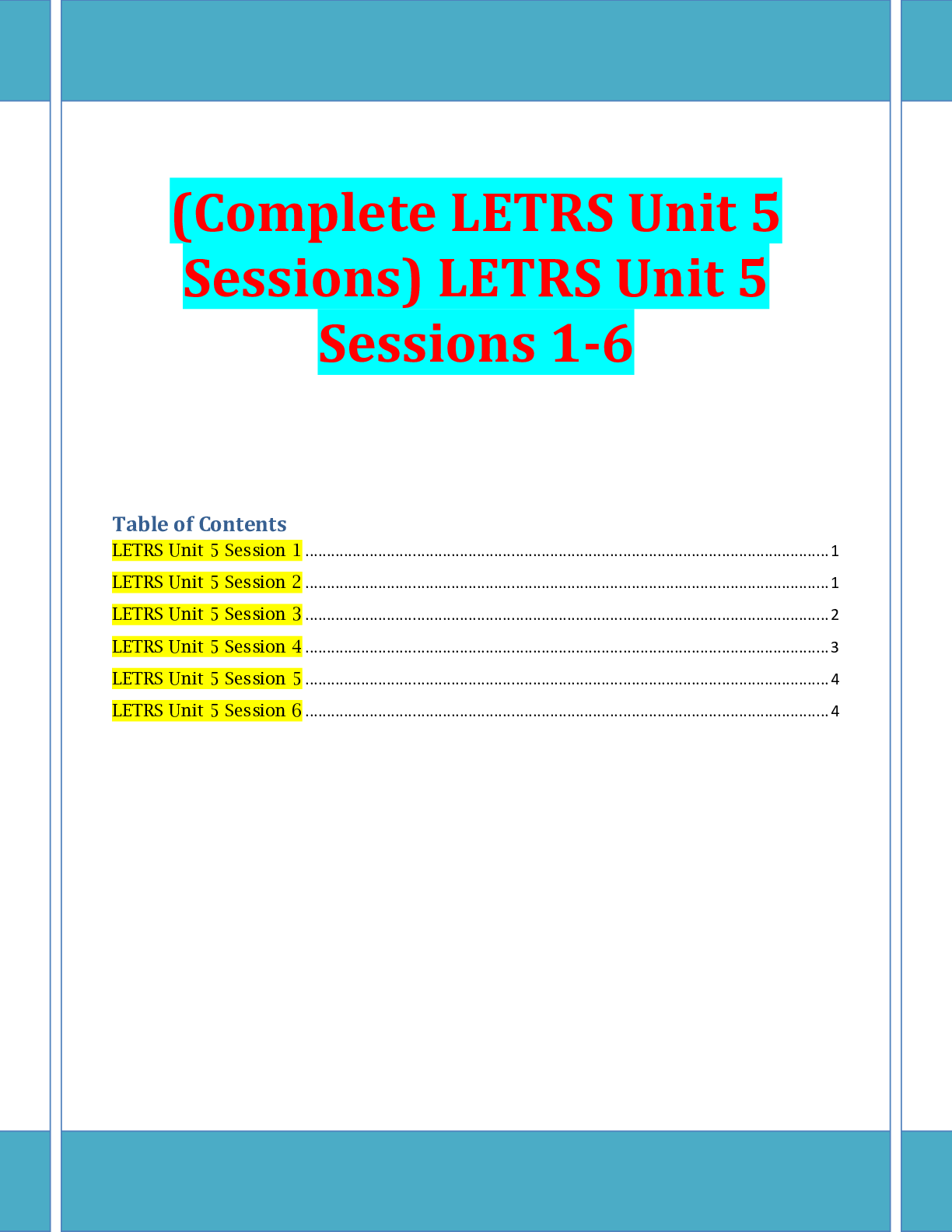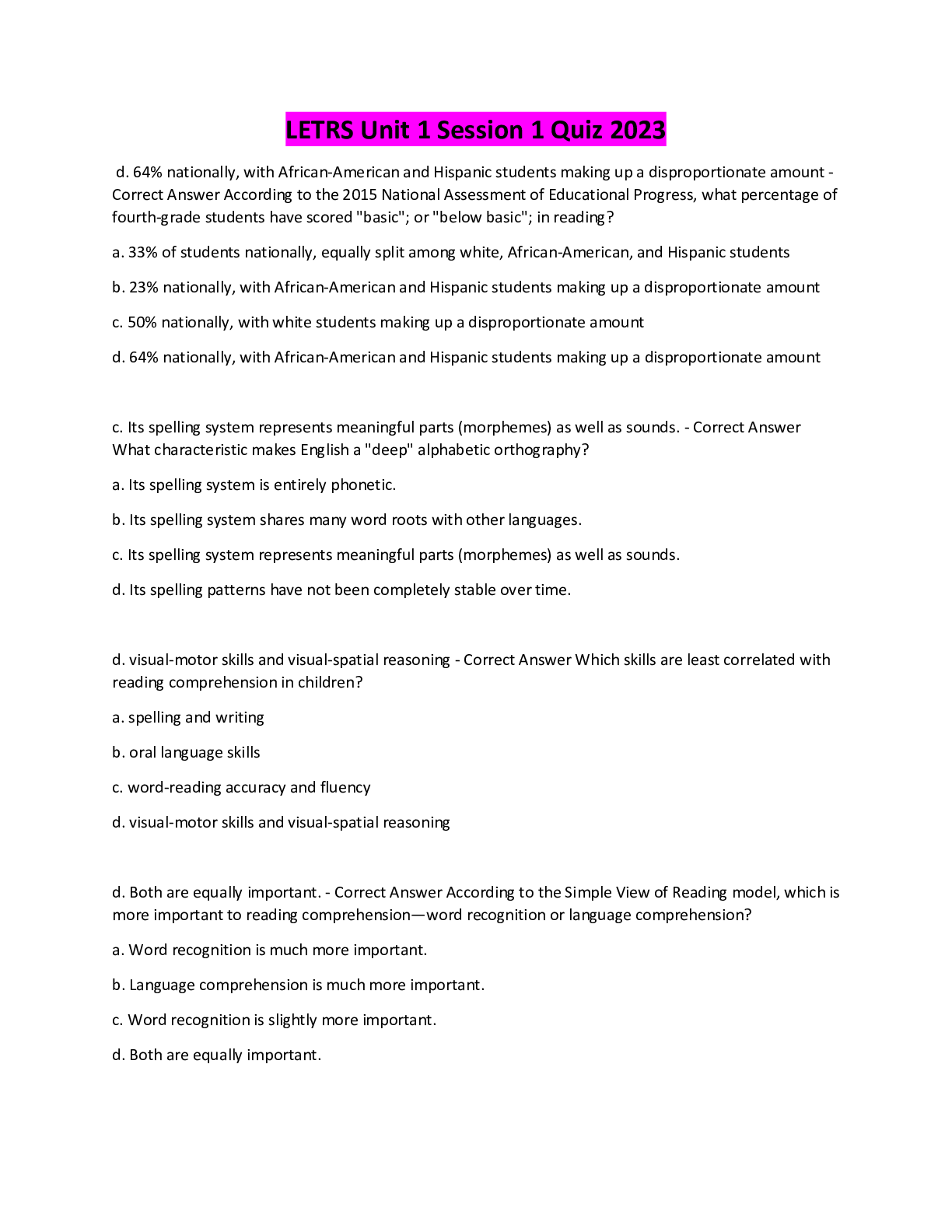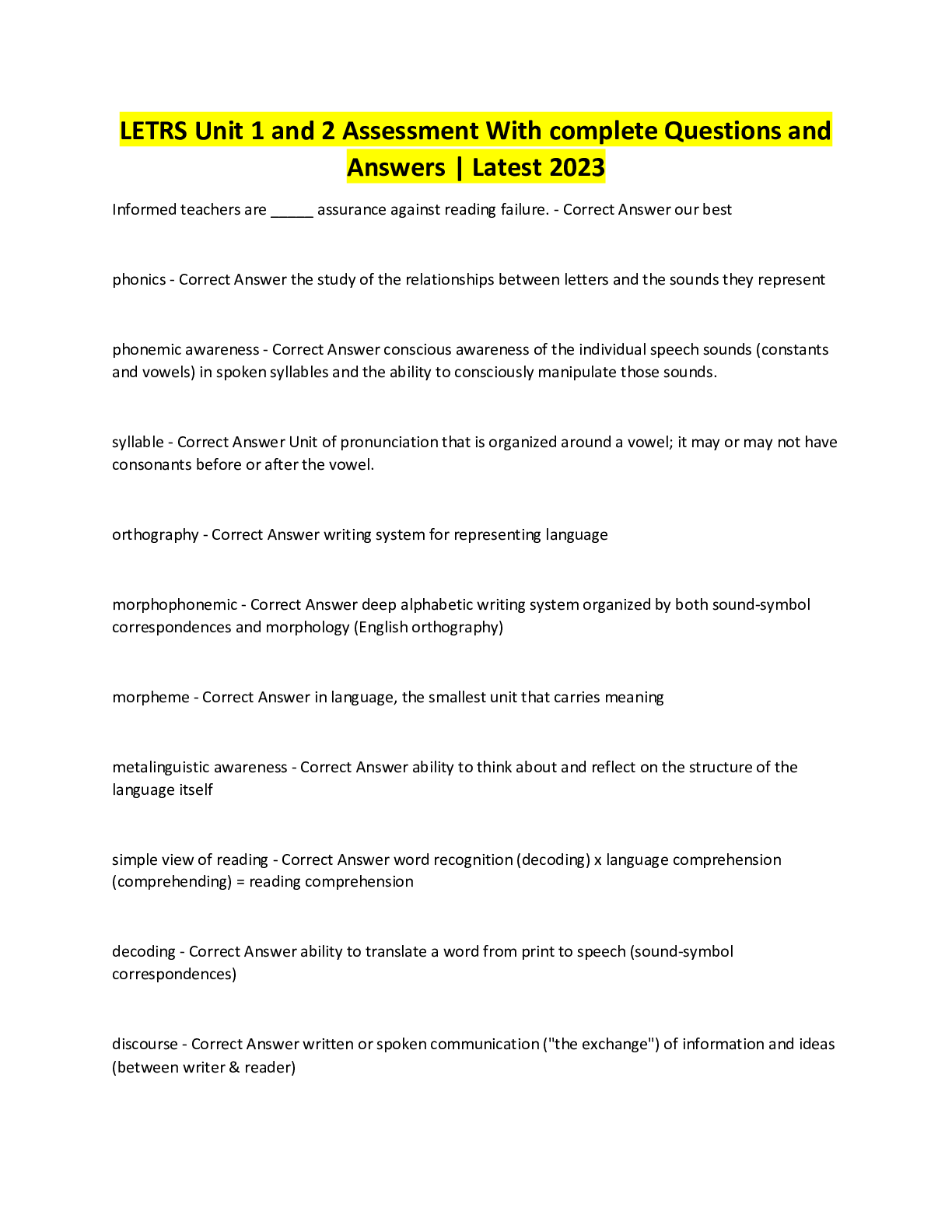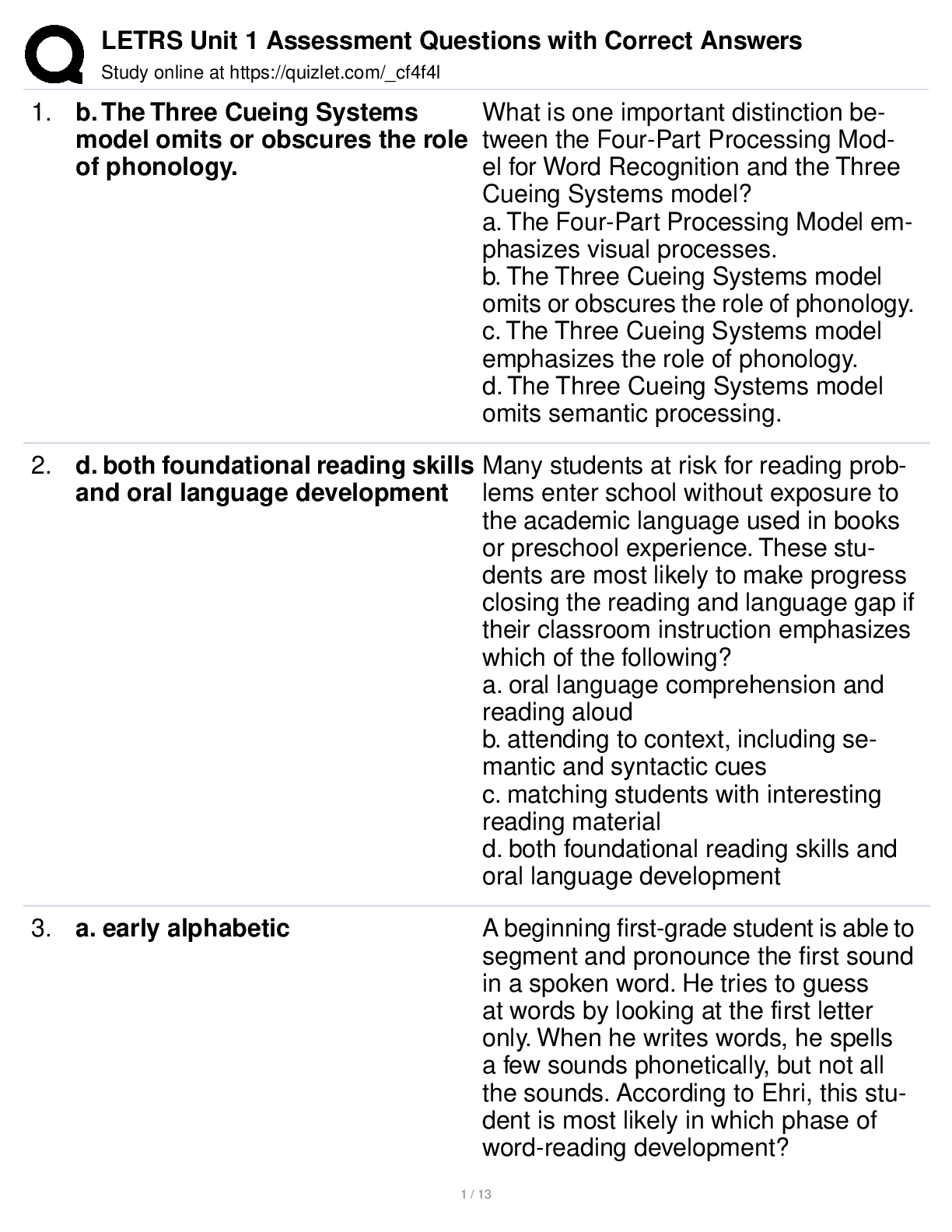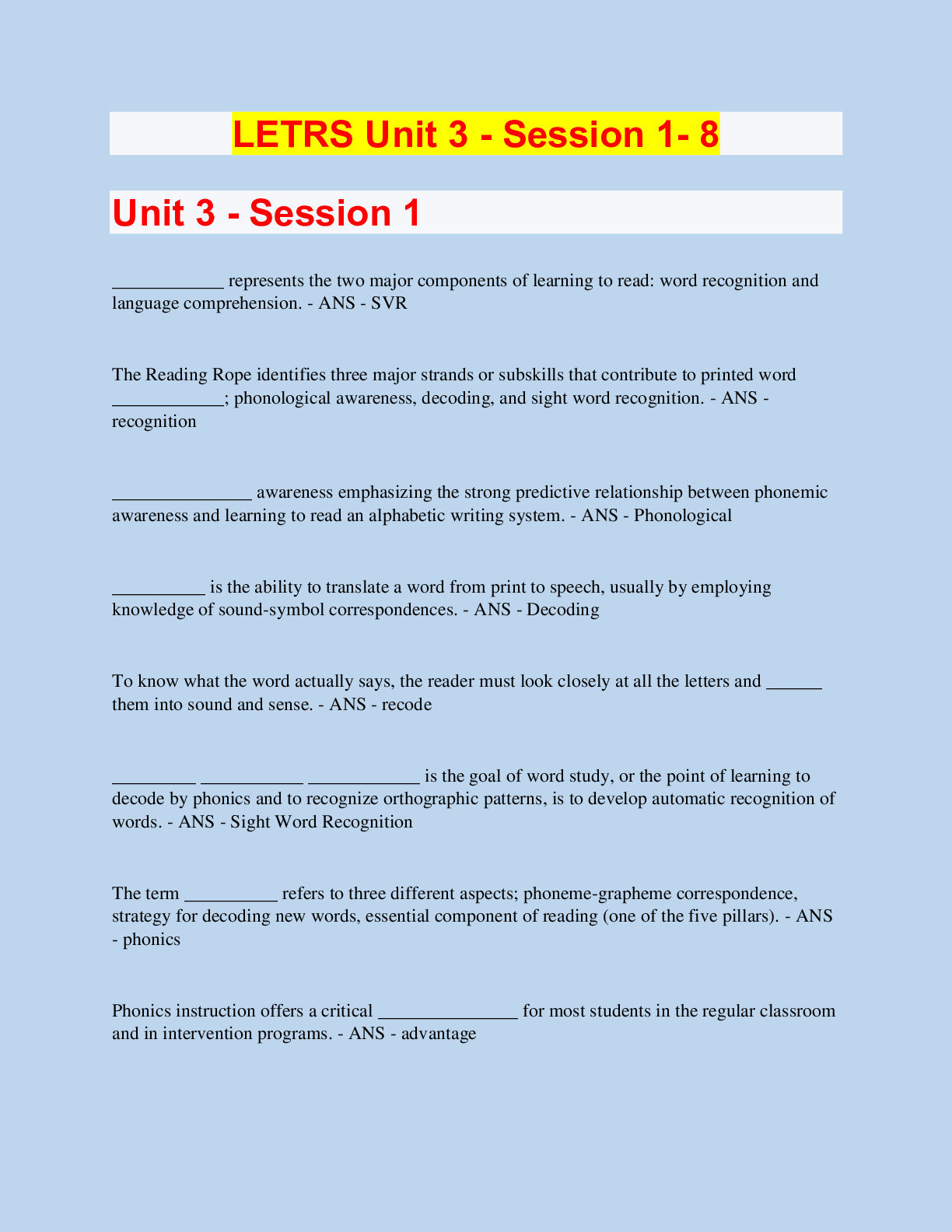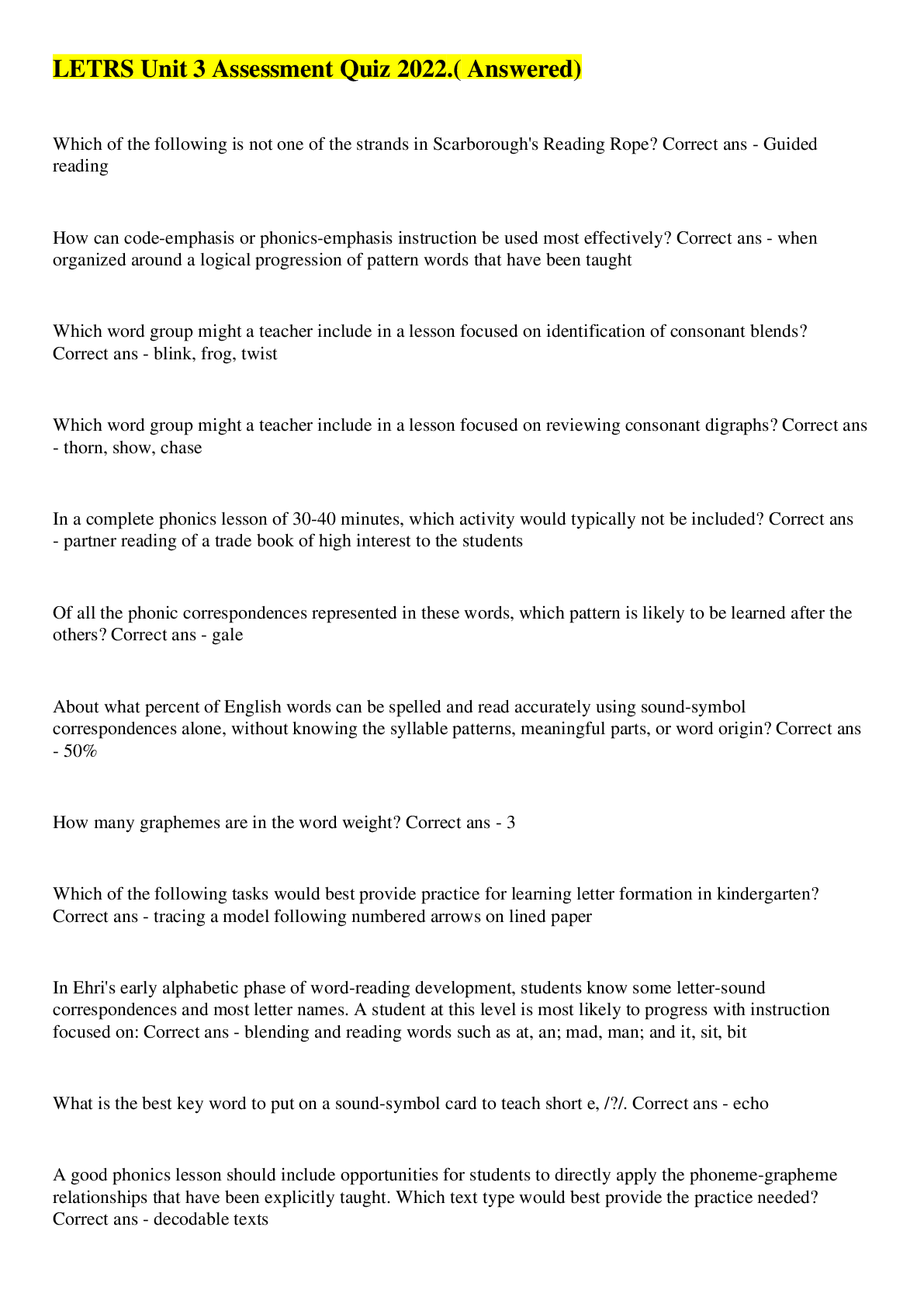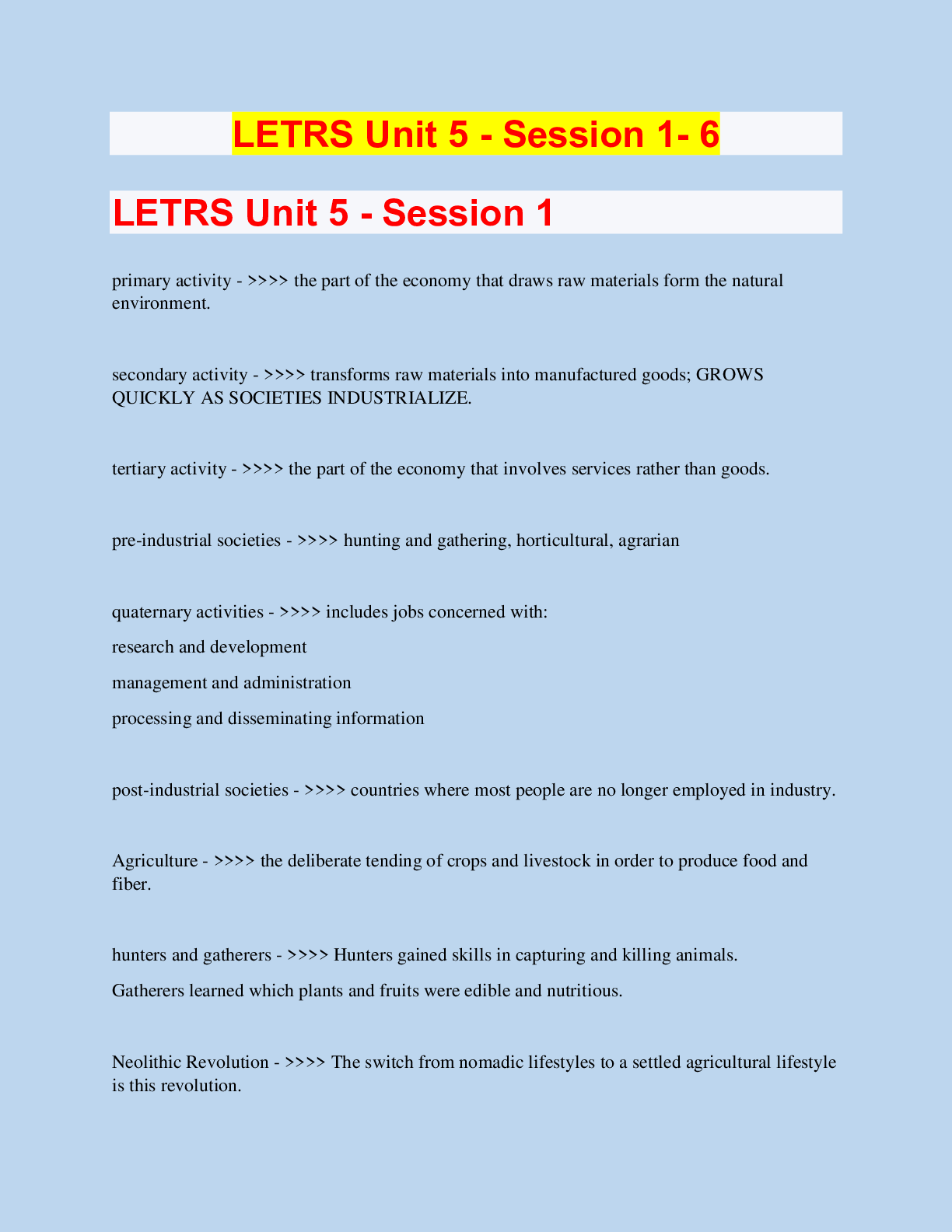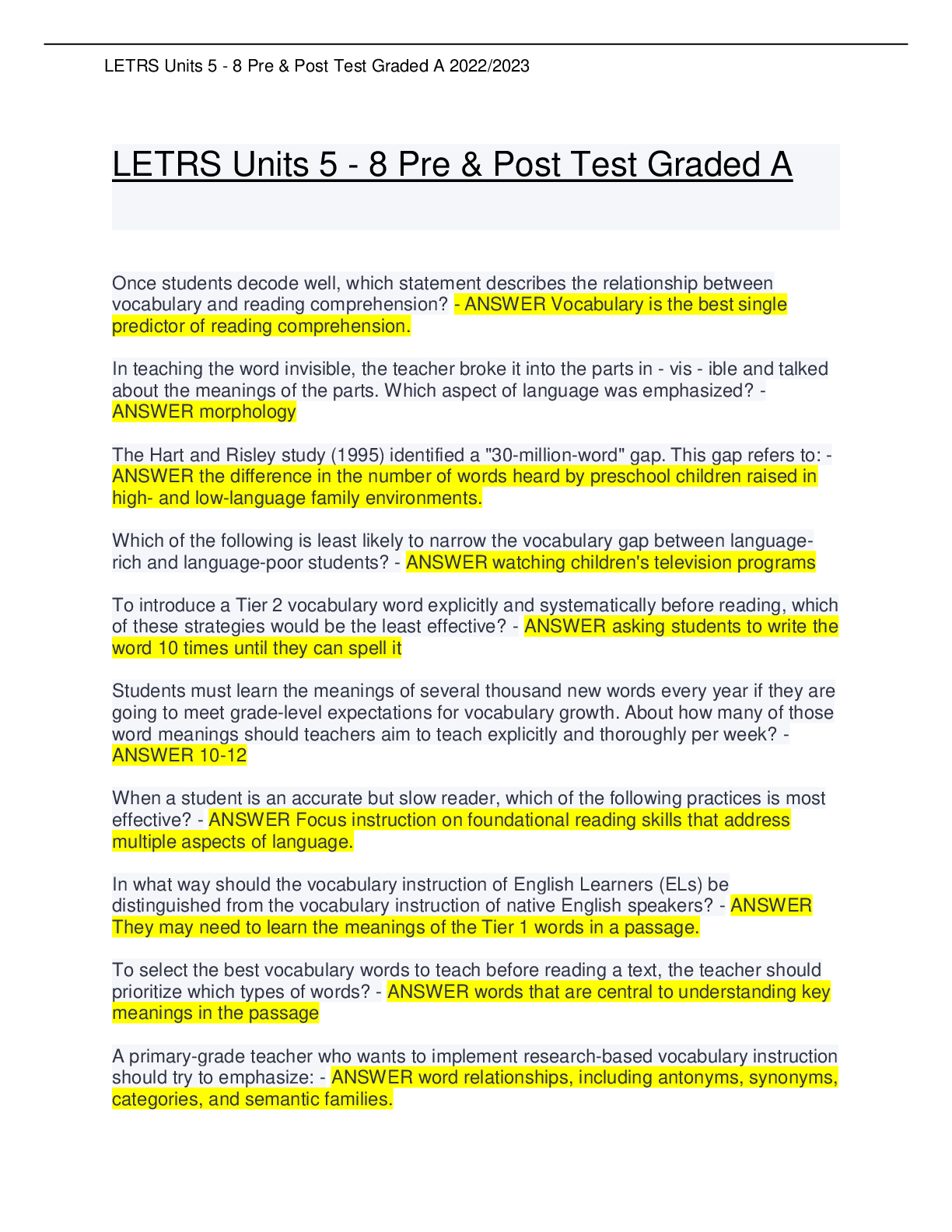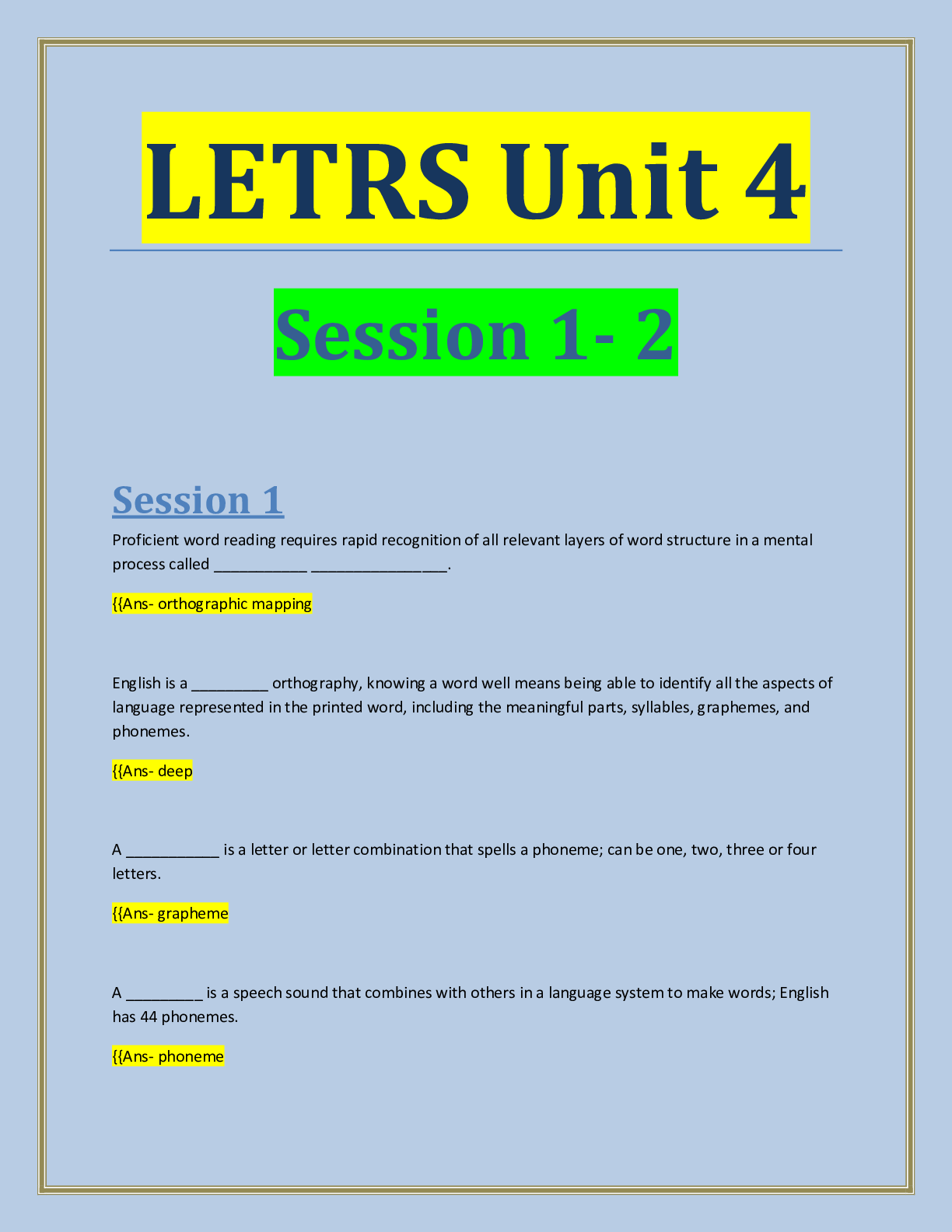Finance > EXAM > Accounting for Decision Makers for MBA WGU- Western Governors University. 60 MCQ with Answers Score (All)
Accounting for Decision Makers for MBA WGU- Western Governors University. 60 MCQ with Answers Score 100%
Document Content and Description Below
Accounting for Decision makers - Western Governors University Multiple-choice questions 1. Businesses use accounting systems to a. Analyze transactions. b. Handle routine bookkeeping tasks. c. Ev... aluate the performance and financial health of the business d. All of the above are correct. 2. Which of the following is NOT a function of accounting? a. Accumulating economic information about organizations. b. Measuring economic information about organizations. c. Executing sales transactions for organizations. d. Communicating economic information about organizations. 3. Which of the following is NOT typically true of accounting information? a. The information is quantitative in nature. b. The information relates to future time periods. c. The information relates to specific accounting entities. d. The information is primarily financial in nature. *** 4. Which of the following financial statements reports the amount of cash collected and paid out by a company? a. Balance sheet. b. Statement of cash receipts and disbursements. c. Income statement. d. Statement of cash flows. 5. Which of the following is NOT one of the three primary financial statements? a. Statement of cash flows. b. Income statement. c. Statement of retained earnings. d. Balance sheet. 1 6. Which of the following financial statements reports a company’s resources, obligations, and ownership? a. Balance sheet. b. Income statement. c. Statement of retained earnings. d. Statement of cash flows. 7. Which of the following financial statements reports the excess of a company’s revenues over its expenses? a. Balance sheet. b. Income statement. c. Statement of retained earnings. d. Statement of cash flows. 8. Which of the following is NOT an external user of accounting information? a. Competitors. b. Customers. c. Management. d. Suppliers. 9. The emphasis in financial accounting is to provide financial information to which of the following user groups? a. Management. b. External auditors. c. Internal auditors. d. Investors and creditors. 10.The current standard setting organization for financial accounting in the United States is the a. Financial Accounting Standards Board (FASB). b. International Accounting Standards Board (IASB). c. Securities and Exchange Commission (SEC). d. Internal Revenue Service (IRS). 2 11.Which of the following is NOT true about the Financial Accounting Standards Board (FASB)? a. It develops accounting standards for U.S. companies. b. It is a government agency. c. It seeks consistency for its proposed accounting standards. d. It has no legal authority to enforce the standards it sets. 12.Which of the following organizations has specific legal authority to establish financial accounting standards for publicly held U.S. companies? a. Financial Accounting Standards Board (FASB). b. Security and Exchange Commission (SEC). c. Internal Revenue Service (IRS). d. Public Company Accounting Oversight Board (PCAOB). 13.Increased federal oversight of the audit process resulted from the passage of the following act of Congress: a. Sarbanes-Oxley Act. b. Financial Reports Act. c. Auditing Oversight Act. d. Access to High Standards Act. 14.Which of the following types of accounts are NOT found on the balance sheet? a. Revenues. b. Assets. c. Liabilities. d. Owners’ equity. 15.The basic accounting equation is a. Assets + Liabilities = Owners’ Equity b. Assets + Owners’ Equity = Liabilities c. Liabilities – Owners’ Equity = Assets d. Assets = Liabilities + Owners’ Equity 3 16.Which of the following accounts is the most liquid? a. Cash b. Land c. Accounts Receivable d. Inventory 17.Which of the following distinguishes between current and long-term assets? a. Comparative balance sheet b. Single-step income statement c. Classified balance sheet d. Liquidity balance sheet 18.Cooper Company purchased land for $90,000 in 2010. In 2013, the land is valued at $155,000. The land would appear on the company’s December 31, 2013 balance sheet at a. $90,000. b. $122,500 [($90,000 + $155,000)/2]. c. $155,000. d. $90,000 or $155,000, it’s the company’s choice. 19.The financial statement that presents a summary of the revenues and expenses of a business for a specific period of time, such as a year, is called a(n) a. Statement of Cash Flows. b. Statement of Retained Earnings c. Income Statement. d. Balance Sheet. 4 20.Which of the following statements is TRUE regarding the Statement of Cash Flows prepared using the Direct Method? a. The amount of the cash inflow or cash outflow from operating activities will be different than the amount calculated using the Indirect Method. b. A Statement of Cash Flows prepared under the Direct Method is typically easier for users to understand than a Statement of Cash Flows prepared under the Indirect Method. c. The operating activities section starts with Net Income and is adjusted (reconciled) to cash from (used for) operating activities. d. The format of the investing activities and financing activities sections is different from the format of these sections prepared using the Indirect Method. 21.Which of the following is an overall measure of the economic performance of a business entity’s activities? a. Revenues b. Net income (or net loss) c. Assets d. Owners’ equity 22.Which of the following would be included on an income statement? a. Cash b. Accounts receivable c. Land d. Cost of goods sold 23.Expense and revenue accounts appear on the a. Balance sheet. b. Income statement. c. Statement of retained earnings. d. None of the above. 5 24. In completing an audit of a company’s financial statements, external auditors a. Guarantee that the financial statements are accurate and free of mistakes. b. Examine every transaction underlying the financial statements. c. Assume responsibility for the accuracy of the financial statements. d. Provide some assurance that the financial statements are not misleading. 25.The accuracy of the information contained in the financial statements is the responsibility of the a. External auditors. b. Internal auditors. c. Management. d. Securities and Exchange Commission (SEC). 26.Which of the following is an asset? a. Notes payable b. Mortgage payable c. Accounts receivable d. Unearned revenue 27.Which of the following would be classified as a long-term asset? a. A notes payable due in 18 months. b. Land c. Cash d. Inventory 28.Which of the following would be classified as a current asset? a. Accounts payable b. Building c. Capital stock d. Accounts receivable 6 29.Which of the following is considered a liability? a. Equipment b. Retained earnings c. Interest payable d. Capital stock 30.Which of the following would be classified as a current liability? a. Accounts payable b. Inventory c. Bank loan due in 24 months d. Prepaid rent 31.Which of the following would be classified as a noncurrent liability? a. Wages payable b. Bank loan due in 6 months c. Investment in the stock of another company. d. Portion of mortgage payable not due within the next 12 months 32.Which of the following is NOT considered to be an owners’ equity account? a. Capital stock. b. Retained earnings c. Gain d. All of these are owners’ equity accounts 7 33.Given the following information, compute operating income. Cost of goods sold $2,000 Income taxes 350 Interest expense 200 Operating expenses 1,500 Sales 5,500 a. $1,280 b. $1,450 c. $2,000 d. $3,500 34.Given the following information, compute net income. Cost of goods sold $2,000 Income taxes 350 Interest expense 200 Operating expenses 1,500 Sales 5,500 a. $1,280 b. $1,450 Net Income = Gross Income - Expenses c. $2,000 d. $3,500 35.Given the following information, compute gross profit. Cost of goods sold $2,000 Income taxes 350 Interest expense 200 Operating expenses 1,500 Sales 5,500 a. $1,280 b. $1,450 c. $2,000 d. $3,500 Gross Profit = Sales - Cost of Goods 8 36.The following information was taken from the records of Thompson Corporation for the year ended December 31, 2013: Dividends paid $ 12,800 Service revenue 90,500 Accounts payable 139,750 Capital stock 378,750 Total expenses 67,000 Retained earnings (at 1/1/2013) 43,400 The net income at December 31, 2013 was a. $23,500 b. $54,100 c. $43,400 d. $72,750 37.Which of the following is a revenue generating activity? a. Borrowing money from a bank. b. Paying rent. c. Service is provided. d. Issuing capital stock. 38.When revenue and expense items are arranged to highlight important profit relationships, the resulting income statement format is called a a. single-step income statement. b. comparative income statement. c. multiple-step income statement. d. classified income statement. 39.A wholesale bakery would normally recognize revenue when a. the product is available for sale to a customer. b. goods are delivered to the customer. c. cash is received from the customer. d. management chooses to do so. 9 40.Which of the following is NOT an acceptable basis for the recognition of expenses? a. Cash disbursement. b. Direct matching. c. Immediate recognition. d. Systematic and rational allocation. 41.Which of the following is NOT a reason for problems occurring in the financial statements? a. Fraud b. Disagreement c. Errors d. Internal controls 42.Which of the following does Sarbanes-Oxley NOT require management to do? a. Develop and enforce an officer code of ethics. b. Approve all loans to executive officers and directors. c. Prepare a statement to accompany the audit report. d. Support a strong board and audit committee in their company. 43.Which of the following activities would internal auditors NOT typically perform in a large company? a. Evaluate internal controls. b. Assist with increasing the efficiency of operations. c. Prepare the financial statements. d. Detect fraud. 44.All of the following are likely to be methods that could be used to conduct fraud EXCEPT a. Creating fictitious invoices. b. Overstating liabilities. c. Not recording various expenses. d. Overstating accounts receivables. 10 45.Which of the following is NOT an objective of the accounting system? a. Make sure a company values transactions properly. b. Make sure a company only records valid transactions. c. Make sure a company only records profitable transactions. d. Make sure a company records transactions in the proper time period. 46.Which of the following is an example of an adequate segregation of duties? a. Greg is in charge of recording receipt of payments made to accounts receivable, while Susan is in charge of making deposits to the bank. b. John, a clerk, is authorized to perform transactions as large as $5,000 but must obtain authorization from Andrea to perform larger transactions. c. Every year, Doug is required to take one full week of vacation time. d. Every evening, Shellie makes a back-up file of all transactions recorded on the computer that day, burns the back-up file onto a CD, and then locks the CD into a fire-proof vault. 47.Which of the following is an example of a physical control over assets and records? a. Greg is in charge of recording receipt of payments made to accounts receivable, while Susan is in charge of making deposits to the bank. b. John, a clerk, is authorized to perform transactions as large as $5,000 but must obtain authorization from Andrea to perform larger transactions. c. Every year, Doug is required to take one full week of vacation time. d. Every evening, Shellie makes a back-up file of all transactions recorded on the computer that day, burns the back-up file onto a CD, and then locks the CD into a fire-proof vault. 48.Internal controls are designed to help and protect all of the following groups of people, EXCEPT a. Creditors. b. Management. c. Investors. d. Tax collectors. 11 49.As William is preparing the end of year financial statements, he notices that the numbers required for his personal bonus have not been met. He reviews the estimates that he has made and adjusts some accounting numbers to meet the requirements for his bonus. This is an example of a. Meeting internal targets. b. Income smoothing. c. Meeting external expectations. d. Window dressing. 50.As William is preparing the end of year financial statements, he realizes that the earnings are not quite up to par for the large loan application that is being currently processed. He decides to stretch the assumptions just enough to be able to meet the requirements for the loan application. This is an example of a. Meeting internal targets. b. Meeting expectations of internal auditors. c. Meeting external expectations. d. Meeting requirements of Sarbanes-Oxley Act. 51.William’s actions in #49 and #50 above are examples of a(n) a. Disagreement. b. Error. c. Fraud. d. None of the above. 52.According to Sarbanes-Oxley, which of the following services are external auditors permitted to provide to its audit client? a. Legal services and expert services unrelated to the audit. b. Internal audit outsourcing services. c. Bookkeeping or other services related to the accounting records or financial statements. d. Opinions about the reliability of internal controls. 12 53.According to Sarbanes-Oxley, who are the external auditors required to report to and be retained by? a. Chief Executive Officer. b. Audit Committee. c. Internal Auditors. d. Chief Financial Officer. 54.The Public Company Accounting Oversight Board (PCAOB) is NOT required to a. Conduct inspections of external auditing firms. b. Enforce compliance with the Foreign Corrupt Practices Act. c. Establish standards relating to the preparation of audit reports for public companies. d. Register external auditing firms that provide audits for public companies. 55.The Sarbanes-Oxley Act establishes a. Constraints on company management. b. Constraints on external auditors. c. Independent oversight of external auditors. d. All of the above are correct. 56.The internal audit manager reports directly to a. Public Company Accounting Oversight Board (PCAOB). b. Controller. c. Audit Committee. d. External Auditors. 13 [Show More]
Last updated: 1 year ago
Preview 1 out of 13 pages
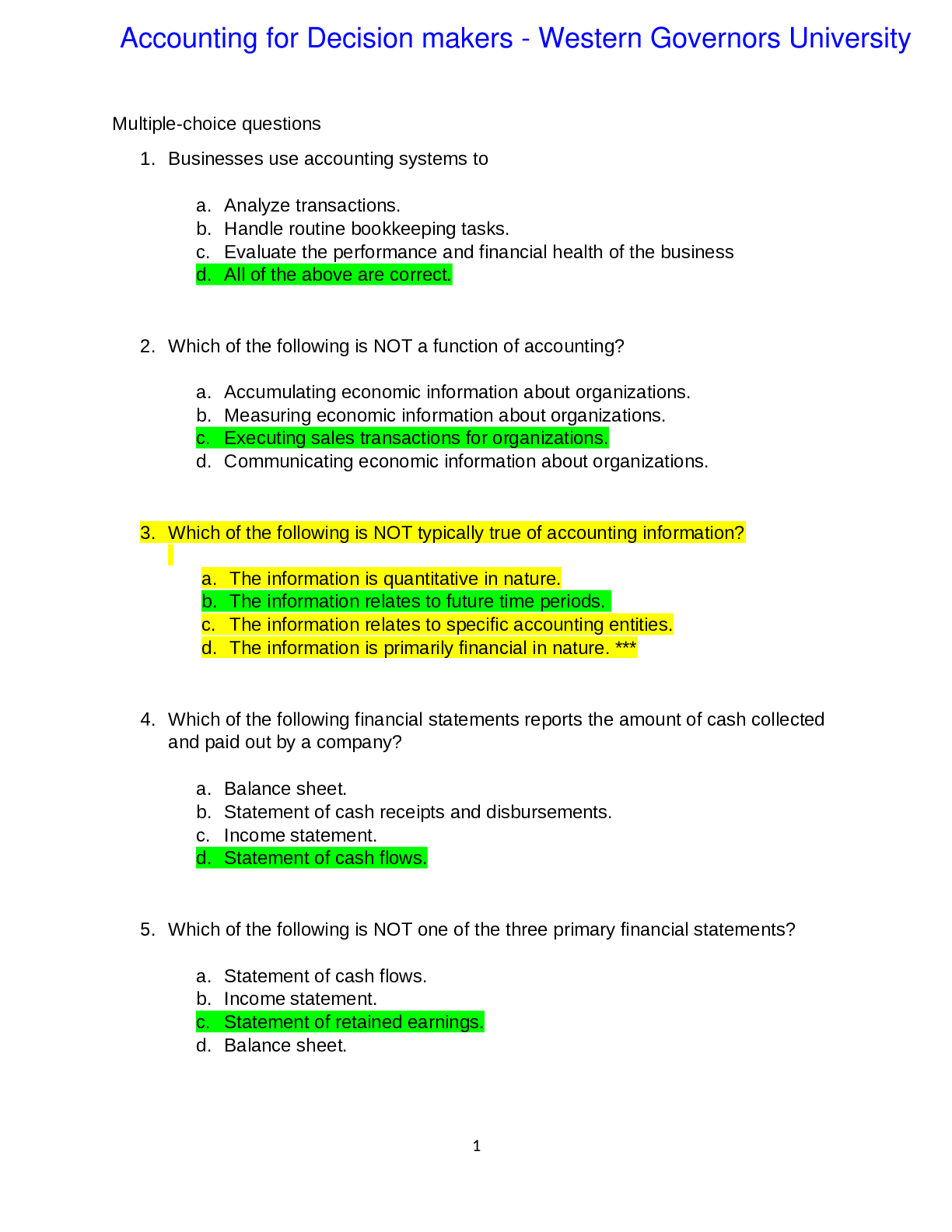
Reviews( 0 )
Document information
Connected school, study & course
About the document
Uploaded On
Mar 04, 2023
Number of pages
13
Written in
Additional information
This document has been written for:
Uploaded
Mar 04, 2023
Downloads
0
Views
1850


